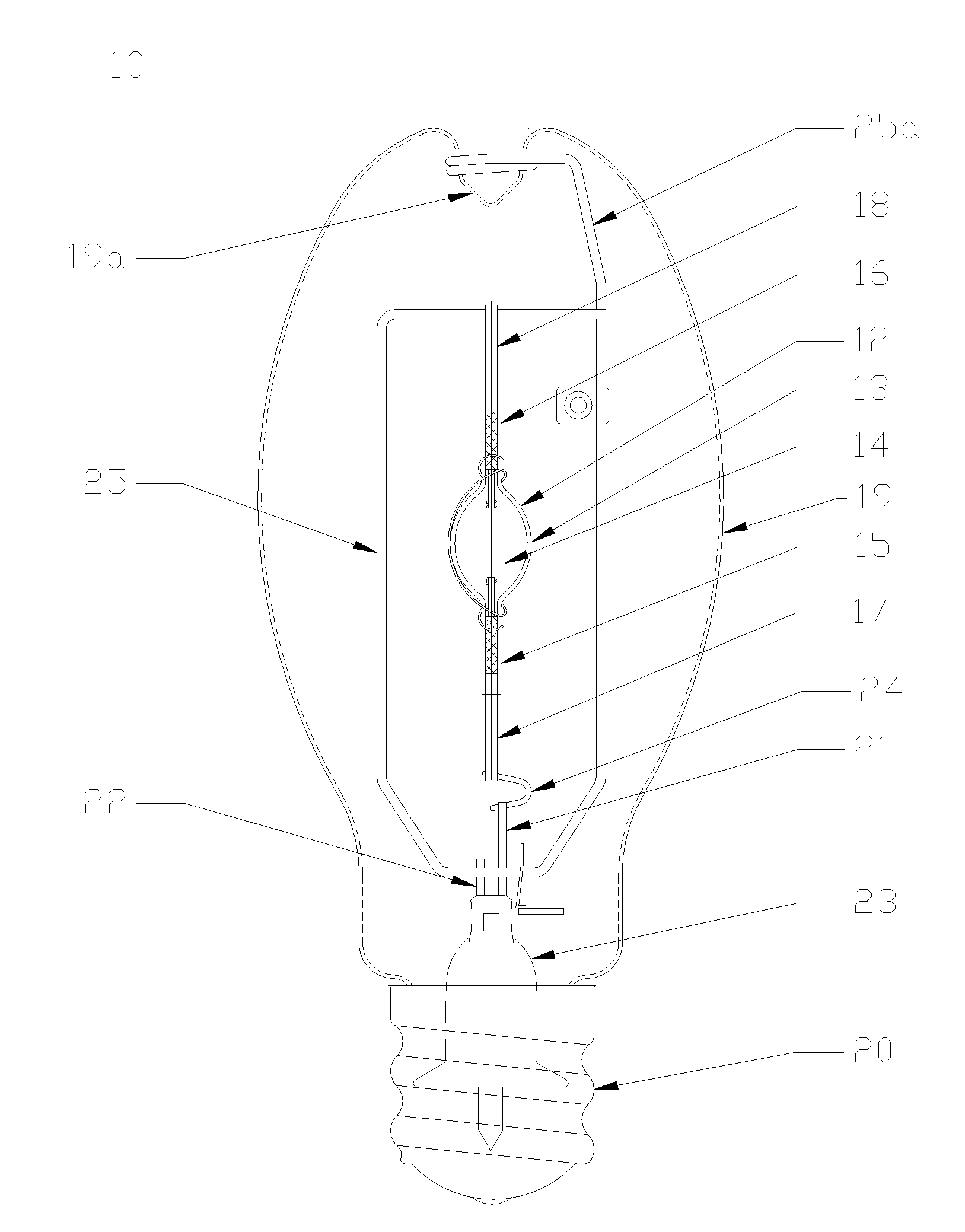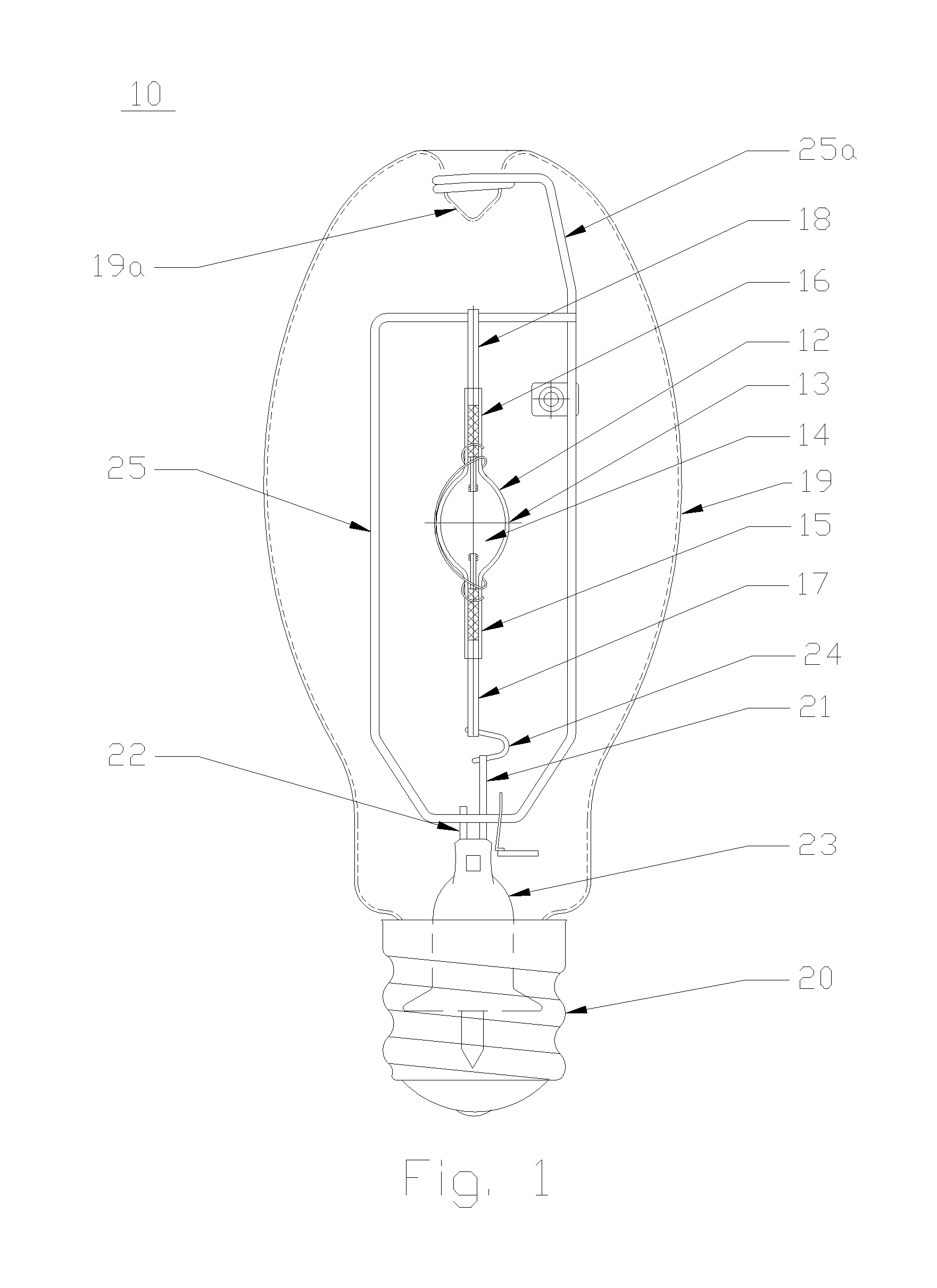Ceramic gas discharge metal halide lamp
a metal halide lamp and ceramic gas technology, applied in the direction of gas discharge lamp details, electric discharge tubes, electrical apparatus, etc., can solve the problems of not suitable retrofits for hpi or hp lamps, xenon gas tends to increase the ignition voltage of lamps, and argon is not as good as xenon, so as to reduce the ignition voltage and reliable ignition
- Summary
- Abstract
- Description
- Claims
- Application Information
AI Technical Summary
Benefits of technology
Problems solved by technology
Method used
Image
Examples
example 1
[0032]In order to demonstrate some advantages of the invention, two sets of medium wattage (400 W) CDM lamps (with and without antennas) were fabricated for testing, having fills of starting gas of argon and a trace amount of radioactive krypton85 according to the prior art and a neon-argon Penning mixture of 99.5 mole percent neon and 0.5 mole percent argon according to the invention, respectively. The lamps employed elliptically-shaped discharge vessels having an outer diameter of 18.4 mm, a total length of 68 mm and a wall thickness of 1 mm. The starting gas fill pressure was 100 mbar. The average mercury dose was ˜37 mg. The metal halide salt mixture included sodium, calcium, manganese, thallium, and rare earth iodides at a dosing level of 40 mg. The total of rare earth iodides was 3 mole percent. The lamp was dosed with an oxygen dispenser as disclosed in U.S. Pat. No. 6,362,571, the entire specification of which is incorporated herein by reference.
[0033]The electrode dimension...
example 2
[0035]Two sets of 400 W CDM lamps of the type shown in FIG. 1 were prepared as described in Example 1, except that the starting gas fill for both sets was Ne:Ar (95%:0.5%); the fill gas pressure was 100 mbar; and the aspect ratio of the discharge vessel was 1.4.
[0036]In addition, one set of the lamps were provided with a starting aid in the form of a floating antenna made of Mo. The distance a between the antenna and a discharge electrode was 5 mm.
[0037]Starting was evaluated using two types of ballasts, both designed for high pressure mercury vapor lamps. The first ballast was a CWA ballast made by Advance Transformer Co. according to American National Standard ANSI code H33 (OCV of 300v), ballast product number 71A 4091, and the second ballast was a reactor ballast made by MWH, ballast product number 260338.
[0038]The lamps without an antenna started at nominal power, but did not start at −10 percent nominal power. The lamps with an antenna started at −10% of the nominal rated powe...
PUM
| Property | Measurement | Unit |
|---|---|---|
| pressure | aaaaa | aaaaa |
| pressure | aaaaa | aaaaa |
| aspect ratio | aaaaa | aaaaa |
Abstract
Description
Claims
Application Information
 Login to View More
Login to View More - R&D
- Intellectual Property
- Life Sciences
- Materials
- Tech Scout
- Unparalleled Data Quality
- Higher Quality Content
- 60% Fewer Hallucinations
Browse by: Latest US Patents, China's latest patents, Technical Efficacy Thesaurus, Application Domain, Technology Topic, Popular Technical Reports.
© 2025 PatSnap. All rights reserved.Legal|Privacy policy|Modern Slavery Act Transparency Statement|Sitemap|About US| Contact US: help@patsnap.com



